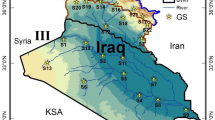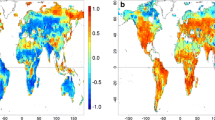Abstract
The main objective of this study is to analyse the near-surface soil moisture fields over the Indian region from two gridded soil moisture datasets and to compare the soil moisture from the above-mentioned datasets with the soil moisture data obtained from the advanced scatterometer (ASCAT). The two soil moisture datasets considered in this study are (i) global land evaporation Amsterdam model (GLEAM) and (ii) Indian monsoon data assimilation and analysis (IMDAA). The IMDAA soil moisture is obtained from modelled output that assimilates soil moisture, while the soil moisture estimates from the GLEAM dataset are derived from both satellite and modelled observations. The results of this study indicate that the differences of ASCAT soil moisture with GLEAM soil moisture are consistently lower than the differences of ASCAT soil moisture with IMDAA soil moisture over all the four seasons in the period 2008–2012. Also, quantitative measures such as improvement parameter (IP), forecast parameter (FP), spatial and temporal correlation are obtained using the two datasets and the ASCAT data to further quantify the relative closeness of the datasets with ASCAT data. The results of these quantitative measures clearly indicate that over the Indian region, the GLEAM near-surface soil moisture data are closer to the ASCAT soil moisture data when compared to the IMDAA near-surface soil moisture data over all seasons for the period 2008–2012. Also, GLEAM soil moisture dataset has lower root mean square error value as compared to IMDAA soil moisture dataset over all seasons and for the period 2008–2012. Also, the results of the IP and FP indicate that the largest percentage of grid cells over which GLEAM data are closer to ASCAT are in the post-monsoon season (October and November). Based on the spatial correlation of near-surface soil moisture between IMDAA, GLEAM and ASCAT, the largest spatial correlation values are observed during the south-west Indian monsoon. The results of temporal correlation reveal that the ASCAT and GLEAM datasets have higher correlation coefficient (CC) values as compared to the CC values corresponding to the ASCAT and IMDAA datasets over most regions of India and over most of the seasons considered.
Research highlights
-
The differences of advanced scatterometer (ASCAT) soil moisture with global land evaporation Amsterdam model (GLEAM) soil moisture are consistently lower than the differences of ASCAT soil moisture with Indian monsoon data assimilation and analysis (IMDAA) soil moisture for all the four seasons for 2012.
-
The results indicate that the GLEAM dataset is closer to ASCAT data using quantitative measures such as improvement parameter, forecast parameter and spatial correlation.
-
The results of temporal correlation reveal that the ASCAT and GLEAM datasets have higher correlation coefficient (CC) values as compared to the CC values corresponding to the ASCAT and IMDAA datasets over most regions of India and over most of the seasons considered.








Similar content being viewed by others
References
Agrawal S and Chakraborty A 2020 Evaluation of ESACCI satellite soil moisture product using in-situ CTCZ observations over India; J. Earth Syst. Sci. 129(1) 129, https://doi.org/10.1007/s12040-020-01384-2.
Albergel C, Calvet J-C, de Rosnay P, Balsamo G, Wagner W, Hasenauer S, Naeimi V, Martin E, Bazile E, Bouyssel F and Mahfouf J-F 2010 Cross-evaluation of modelled and remotely sensed surface soil moisture with in situ data in southwestern France; Hydrol. Earth Syst. Sci. 14(11) 2177–2191, https://doi.org/10.5194/hess-14-2177-2010.
Albergel C, Dorigo W, Reichle R H, Balsamo G, de Rosnay P, Muñoz-Sabater J, Isaksen L, de Jeu R and Wagner W 2013 Skill and global trend analysis of soil moisture from reanalyses and microwave remote sensing; J. Hydrometeorol. 14(4) 1259–1277, https://doi.org/10.1175/JHM-D-12-0161.1.
Albergel C, Rüdiger C, Carrer D, Calvet J-C, Fritz N, Naeimi V, Bartalis Z and Hasenauer S 2009 An evaluation of ASCAT surface soil moisture products with in-situ observations in Southwestern France; Hydrol. Earth Syst. Sci. 5, https://doi.org/10.5194/hessd-5-2221-2008.
Asharaf S, Dobler A and Ahrens B 2012 Soil moisture-precipitation feedback processes in the Indian summer monsoon season; J. Hydrometeorol. 13 1461–1474, https://doi.org/10.1175/JHM-D-12-06.1.
Ashrit R, Indira Rani S, Kumar S, Karunasagar S, Arulalan T, Francis T, Routray A, Laskar S I, Mahmood S, Jermey P, Maycock A, Renshaw R, George J P and Rajagopal E N 2020 IMDAA regional reanalysis: Performance evaluation during Indian summer monsoon season; J. Geophys. Res. Atmos. 125(2) e2019JD030973, https://doi.org/10.1029/2019JD030973.
Brocca L, Melone F and Moramarco T 2010 ASCAT soil wetness index validation through in-situ and modeled soil moisture data in Central Italy; Remote Sens. Environ. 114 2745–2755, https://doi.org/10.1016/j.rse.2010.06.009.
Brocca L, Moramarco T, Melone F and Wagner W 2013 A new method for rainfall estimation through soil moisture observations; Geophys. Res. Lett. 40(5) 853–858, https://doi.org/10.1002/grl.50173.
Davies T, Cullen M J P and Malcolm A J 2005 A new dynamical core for the Met Office’s global and regional modelling of the atmosphere; Quart. J. Roy. Metereol. Soc. 131 1759–1782, https://doi.org/10.1256/qj.04.101.
Douville H and Chauvin F 2000 Relevance of soil moisture for seasonal climate predictions: A preliminary study; Clim. Dyn. 16 719–736, https://doi.org/10.1007/s003820000080.
Draper C S, Reichle R H, De Lannoy G J M and Liu Q 2012 Assimilation of passive and active microwave soil moisture retrievals; Geophys. Res. Lett. 39(4), https://doi.org/10.1029/2011GL050655.
Eltahir E A B 1998 A soil moisture–rainfall feedback mechanism: 1. Theory and observations; Water Resour. Res. 34 765–776, https://doi.org/10.1029/97WR03499.
Guillod B P, Orlowsky B, Miralles D G, Teuling A J and Seneviratne S I 2015 Reconciling spatial and temporal soil moisture effects on afternoon rainfall; Nat. Commun. 6(1) 6443, https://doi.org/10.1038/ncomms7443.
Kerr Y H, Waldteufel P, Wigneron J-P, Delwart S, Cabot F, Boutin J, Escorihuela M-J, Font J, Reul N, Gruhier C, Juglea S E, Drinkwater M R, Hahne A, Martín-Neira M and Mecklenburg S 2010 The SMOS mission: New tool for monitoring key elements of the global water cycle; Proc. IEEE 98(5) 666–687, https://doi.org/10.1109/JPROC.2010.2043032.
Mahmood S, Davie J, Jermey P, Renshaw R, George J P, Rajagopal E N and Rani S I 2018 Indian monsoon data assimilation and analysis regional reanalysis: Configuration and performance; Atmos. Sci. Lett. 19(3) e808, https://doi.org/10.1002/asl.808.
Martens B, de Jeu R A M, Verhoest N E C, Schuurmans H, Kleijer J and Miralles D G 2018 Towards estimating land evaporation at field scales using GLEAM; Remote Sens. 10(11), https://doi.org/10.3390/rs10111720.
Martens B, Miralles D G, Lievens H, van der Schalie R, de Jeu R A M, Fernández-Prieto D, Beck H E, Dorigo W A and Verhoest N E C 2017 GLEAM v3: Satellite-based land evaporation and root-zone soil moisture; Geosci. Model Dev. 10(5) 1903–1925, https://doi.org/10.5194/gmd-10-1903-2017.
Miralles D G, Holmes T R H, de Jeu R A M, Gash J H, Meesters A G C A and Dolman A J 2011 Global land-surface evaporation estimated from satellite-based observations; Hydrol. Earth Syst. Sci. 15(2) 453–469, https://doi.org/10.5194/hess-15-453-2011.
Pangaluru K, Velicogna I A G, Mohajerani Y, Ciracì E, Charakola S, Basha G and Rao S V B 2019 Soil moisture variability in India: Relationship of land surface–atmosphere fields using maximum covariance analysis; Remote Sens. 11(3), https://doi.org/10.3390/rs11030335.
Rani I, Thanigachalam A, George J, Rajagopal E, Renshaw R, Maycock A, Barker D and Rajeevan M 2021 IMDAA: High resolution satellite-era reanalysis for the Indian monsoon region; J. Clim. 1–78, https://doi.org/10.1175/JCLI-D-20-0412.1.
Schneider S, Wang Y, Wagner W and Mahfouf J-F 2014 Impact of ASCAT soil moisture assimilation on regional precipitation forecasts: A case study for Austria; Mon. Weather Rev. 142, https://doi.org/10.1175/MWR-D-12-00311.1.
Seneviratne S I, Corti T, Davin E L, Hirschi M, Jaeger E B, Lehner I, Orlowsky B and Teuling A J 2010 Investigating soil moisture–climate interactions in a changing climate: A review; Earth Sci. Rev. 99(3) 125–161, https://doi.org/10.1016/j.earscirev.2010.02.004.
Sinclair S and Pegram G G S 2010 A comparison of ASCAT and modelled soil moisture over South Africa, using TOPKAPI in land surface model; Hydrol. Earth Syst. Sci. 14(4) 613–626, https://doi.org/10.5194/hess-14-613-2010.
Singh R P, Mishra D, Sahoo A and Dey S 2005 Spatial and temporal variability of soil moisture over India using IRS P4 MS NIR data; Int. J. Remote Sens. 26 2241–2247, https://doi.org/10.1080/01431160500043723.
Szczypta C, Calvet J-C, Maignan F, Dorigo W, Baret F and Ciais P 2014 Suitability of modelled and remotely sensed essential climate variables for monitoring Euro-Mediterranean droughts; Geosci. Model Dev. 7(3) 931–946, https://doi.org/10.5194/gmd-7-931-2014.
Unnikrishnan C K, George J, Lodh A, Maurya D, Mallick S, Rajagopal E and Mohandas S 2016 Validation of two gridded soil moisture products over India with in-situ observations; J. Earth Syst. Sci. 125, https://doi.org/10.1007/s12040-016-0714-x.
Unnikrishnan C K, Rajeevan M, Vijaya Bhaskara Rao S and Kumar M 2013 Development of a high resolution land surface dataset for the south Asian monsoon region; Curr. Sci. 105(9) 1235–1246.
Varikoden H and Revadekar J V 2018 Relation between the rainfall and soil moisture during different phases of Indian monsoon; Pure Appl. Geophys. 175(3) 1187–1196, https://doi.org/10.1007/s00024-017-1740-6.
Wagner W, Hahn S, Kidd R, Melzer T, Bartalis Z, Hasenauer S, Figa-saldaña J, Rosnay P, Jann A, Schneider S, Komma J, Kubu G, Brugger K, Aubrecht C, Züger J, Gangkofner U, Kienberger S, Brocca L, Wang Y and Rubel F 2013 The ASCAT soil moisture product: A review of its specifications, validation results, and emerging applications; Meteorol. Z. 22 5–33.
Acknowledgements
The first author thanks the Director, Indian Institute of Space Science and Technology for providing the facilities and support and acknowledges AICTE for providing financial fellowship during the post-graduation study. The first author is thankful to her senior, Ms Pavani, for introducing her to the NCL language and for supporting her all along. The first author thanks Shri Vibin Jose for clarifying doubts regarding the ASCAT data. Both the authors thank the director, National Center for Medium-Range Weather Forecasting (NCMRWF) for IMDAA data and the Global Land Evaporation Model (GLEAM) team for providing the GLEAM dataset. The authors thank National Oceanic and Atmospheric Administration for providing ASCAT data.
Author information
Authors and Affiliations
Contributions
Gayathri Vangala: Collected and processed the data, performed visualization, data analysis and drafted the original manuscript; Dr Anantharaman Chandrasekar: Conceptualized the study, provided critical revisions for the manuscript and supervised the work. The authors hereby declare that the study contained in this paper is an original and bonafide work. This study is not funded from any research project.
Corresponding author
Additional information
Communicated by Kavirajan Rajendran
Rights and permissions
About this article
Cite this article
Vangala, G., Chandrasekar, A. Analysis of soil moisture estimates from global and regional datasets over the Indian region. J Earth Syst Sci 131, 63 (2022). https://doi.org/10.1007/s12040-021-01800-1
Received:
Revised:
Accepted:
Published:
DOI: https://doi.org/10.1007/s12040-021-01800-1




